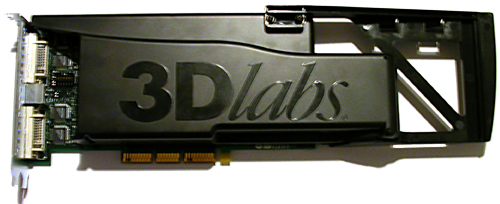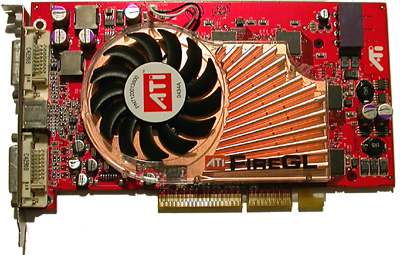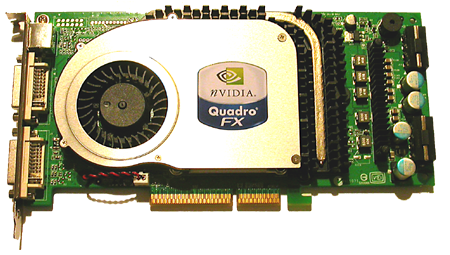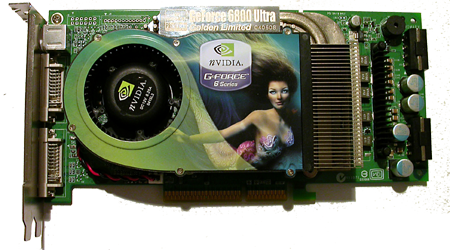Workstation Graphics: AGP Cross Section 2004
by Derek Wilson on December 23, 2004 4:14 PM EST- Posted in
- GPUs
The Cards
We are focusing on 3 workstation cards today, and we will also be using 2 ultra high end desktop cards for reference. Here's the lineup of workstation parts that we will be looking at:| AGP Workstation Graphics Contenders | |||
| 3Dlabs Wildcat Realizm 200 | ATI FireGL X3-256 | NVIDIA Quadro FX 4000 | |
| Street Price | ~$860 | ~$875 | ~$1600 |
| Memory Size/Type | 512MB GDDR3 | 256MB GDDR3 | 256MB GDDR3 |
| Memory Bus | 256bit | 256bit | 256bit |
| Memory Clock | 500MHz | 450MHz | 500MHz |
| Core Clock | ? | 490 | 375 |
| Vertex Pipes | 4 | 6 (4 Full DX9) | 6 |
| Vertex Processing | 36-bit | 32-bit | 32-bit |
| Pixel Pipes | 12 | 12 | 16 |
| Pixel Processing | 32-bit / 16-bit storage | 24-bit | 32-bit / 16-bit selectable |
| Shader Model Support | VS 2.0 / PS 3.0 | SM 2.0 | SM 3.0 |
| 2x Dual-Link DVI | Yes | Yes | Yes |
| Stereo 3D | Yes | Yes | Yes |
| Genlock/Framelock | Multiview Upgrade | No | SDI version |
Clearly, the competition is well matched, with the exception of price. Of course, we don't know the core clock speed of the 3Dlabs part, but recalling the architectural description, looking at the head-to-head numbers and noting the prices of the parts, the tests should prove to be very interesting. Street prices came from looking at what Google and pricewatch had to offer. Here are the images of the workstation cards that we'll be testing:

3Dlabs' Wildcat Realizm 200 High End AGP Workstation card

ATI's FireGL X3-256 AGP Workstation Card

NVIDIA's Quadro FX 4000 High End AGP Workstation Card
The two consumer level cards against which we chose to compare our workstation parts were the most powerful parts that we could dig up in our lab from the ATI and NVIDIA camp.
It used to be that NVIDIA sold the cheapest workstation components by simply overclocking their desktop part and enabling hardware point and line antialiasing. We can see with the most recent Quadro part that their philosophy has changed quite a bit. Unfortunately, we aren't able to force the GeForce 6 Series to hardware accelerate antialiased wireframe drawing, but the 6800 Ultra Golden Limited (is that name a descriptor or what?) that we received from Prolink does a very solid job of pushing data through. It has a 25MHz higher core clock than the 6800 Ultra and it sports 1.15 GHz data rate GDDR3 memory.

Prolink's GeForce 6800 Ultra Golden Limited
From the ATI camp, we employed the ever faithful HIS. Always the best choice in ATI overclocking, HIS shipped us one of their IceQ II series of parts. We had planned to do a roundup, but unfortunately, they were the only vendor to actually ship us a Radeon X800 XT Platinum Edition part. Luckily, the once out-of-work X800 XTPE has recently been re-adopted by ATI in the form of the X850 XT. They may be "different silicon", but to the end user, they are the same part. And so, we're testing with the HIS Radeon X800 XT PE IceQ II both on its legacy as a failed launch product, and as a glimpse at how the X850 XT will run workstation applications (provided ATI actually does get their cards out in January as said they would). Either way, this HIS part is the highest performing ATI based solution that we could dig up to compete with our workstation components.

HIS' Radeon X800 XT PE IceQ II










25 Comments
View All Comments
DerekWilson - Thursday, December 23, 2004 - link
johnsonx,thanks for the suggestion. we're definitly exploring options for other workstation articles.
since this is the first of the graphics workstation articles we've tackled in quite a while, we wanted to start with current technology (R4xx, NV4x, and WC Realizm based parts). There aren't curently lower end parts (with the exception of the Wildcat Realizm 100) based on the technology we tested for this article.
thanks again. let us know if there's anything else we can look into doing for future reviews.
Derek Wilson
johnsonx - Thursday, December 23, 2004 - link
How about benchmarking some of the lower Quadro and FireGL cards? ATI has the FireGL 9600 (aka FireGL T2-128), FireGL 9700 (aka FireGL X1), and FireGL 9800 (aka FireGL X2-256t) at $250, $500 and $600 price points repectively. Comparable Quadros are available as well.For many professional uses, a workstation class card (with attendant workstation class, certified drives) is desired, but ultra-high performance isn't important. It'd be nice to see the comparitive performance of the lower end cards.
DerekWilson - Thursday, December 23, 2004 - link
ksherman,You may have some luck with the 6600gt under AutoCAD, espeically if you don't intend to push the graphics subsystem as much as we did (no AA lines, less tess, etc...), but depending on the Pro/E workload, you may have trouble.
The SPECviewperf veiwset tests a much larger workload than the OCUS benchmark. If you're working with smaller data, you should be fine, but if we're talking millions of verts, you're going to have increasing ammounts of trouble with a 128MB card.
Derek Wilson
ksherman - Thursday, December 23, 2004 - link
You guys should throw in a few mainstream graphics cards for comparison. I am trying to build a systems whos primary use will be with Pro/Engineer and AutoCAD and i certainly do not have the money for a $1000+ video card. Im just wondering how the other cards match up (like the 6600gt AGP)Speedo - Thursday, December 23, 2004 - link
Nice review!